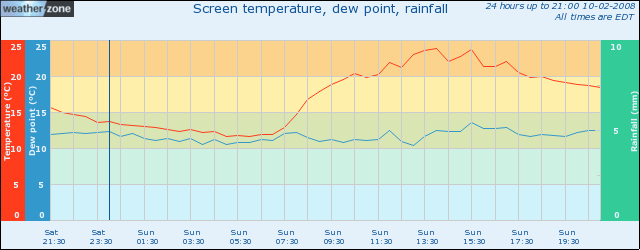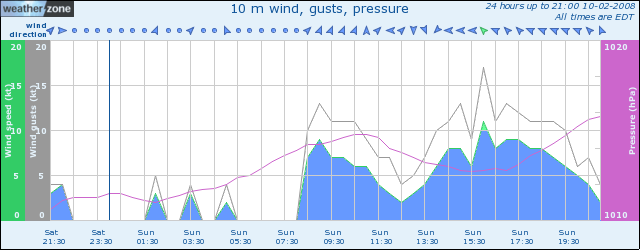Flying Training
Lesson 56: Training Area with Alexander
Sunday 10 February 2008, 9.30am in Citabria VH-MWY.
Weather: Clear at first, cloud developing to the west. Wind SSW 7 gusting to 11 kts.
Alexander was looking forward very much to this flight and asked me a couple of weeks ago to tell him what he could expect. This morning he asked me to tell him exactly what he'd be doing. He's reading The Curious Case of the Dog in the Night-time so he was mainly concerned about when he could read his book and when he'd be in the aircraft.
When we turned up, MWY was still in the hangar so Steve (one of the instructors) helped me pull it out and turn it towards the taxiway so the propwash would be clear of the hangar. I filled out the paperwork, told Steve and Rob what I'd be doing and then Alexander accompanied me on the preflight. We checked the Maintenance Release, and had Steve sign it for the day, and then checked the fuel. Both tanks were completely dry. Interesting. This could mean there was anywhere between zero and 20 litres in the tanks. Because I knew we'd have to fill up, I didn't check the content gauges, but I wonder now what they showed.
So Alexander hopped in the back (this was when he realised that we wouldn't have an instructor with us) and we took the aircraft round for refuelling. We joined the queue (time was ticking by) and then had some fun with the Curtis credit card in the machine, but we eventually put 105 litres in, and when we dipped the tanks found we had 125 litres in total. Alexander was very helpful in carrying the hose around and winding it in at the end.
Finally we were ready. By this time it was approaching ten o'clock but it still gave us a good hour before the next student at 11. I said to Alexander, "Let's go flying", and he hopped in the back. We tightened the waist strap and shoulder harness, plugged in the headphones and I showed him where to find the headset volume control. There's no transmit switch in the instructor's stick, (I assumed it had simply been removed) so I assured Alexander that there was no way that other people could hear what he was saying. Ironic, as it turned out. He asked if he could hear what everyone else was saying, and I said he could. He also asked whether it would be bumpy and I said it shouldn't be.
Having started and checked the ATIS we taxiied to the run-up bay for runway 24 and ran through the checks. The Pitts in front of us was quickly out of the way and we were cleared for take off, with the climb restriction cancelled (so we could climb above circuit height straight after take off).
Alexander's reaction to the take-off was, "Wow!" as the Citabria climbs quickly especially with relatively little weight on board. He was then able to look around him and take an interest in the scene below. We set course for just north of The Oaks, and I explained that it used to be a bomber airfield during the Second World War, but that the tarmac had been ripped up and sold to make roads. He took an interest in the farms, the animals and the dams, and then as we climbed higher, in the area of Lake Burragorang.
I'd hoped to climb to 4500 feet to get a good view to the west, but there was broken cloud with a base at 3500 feet so we had to stay at 2500. Remembering the lack of photographs on Brendan's flight I passed the camera back to Alexander to take a picture of himself, and he did a good job, being very camera-friendly. As I turned north we had the first hint of trouble as Alexander said he felt sick, and asked where the bag was. I reached back with my left arm into the pocket where the sick bags are normally stowed, but there were none. Alexander told me at this stage he definitely needed to be sick so I was relieved when I pulled out the contents of the door pocket to find two crumpled sick bags at the bottom. I passed them back to Alexander and he used one, looking rather sheepish as he did so.
Expecting him to feel better I continued north towards the dam, but he was soon asking where the airport was, and whether we could land. When I replied he asked again, and it soon became clear that he couldn't hear what I was saying. Come to that, I couldn't hear what I was saying, and then I realised I couldn't hear Sydney Radar (which we'd been monitoring), either.
By this time we were at Bringelly and I wanted to check the ATIS and make an inbound call. But I couldn't hear anything on the ATIS, or on Camden's tower frequency. I double-checked the frequencies (125.1 and 120.1 respectively), asked Camden Tower for a radio check, and checked the volume control on the headset, the intercom and COM1. I was getting a strong feeling of deja vu as it became more likely that I'd have to make my second approach and landing without benefit of radio.
In case it was my headset, I swapped mine with Alexander, but that made no difference either. I made the normal inbound call, adding "Transmitting blind." but heard nothing back, so I had no choice but to overfly the airfield at 2000 feet and look for light signals. I saw none, but I was able to clearly see that runway 24 was still in use. There was an aircraft lined up ready for take-off and a Pitts at the hold point, so I made a descending right turn (the direction of circuits on 24) and joined downwind. Looking over towards the tower I still saw no light signals, even when I rocked my wings to try to attract their attention.
So I made a normal downwind call, again suffixed "Transmitting blind.", watched the other aircraft take off, checked that all was clear and made a normal base and final turn. At this point I simply concentrated on the landing. We had a noticeable crosswind from the left, so I dropped that wing slightly and used the rudder to stay on the centreline. After a nice, smooth touchdown we took the first exit taxiway.
I noticed the airfield ute heading my way, and waited for him to pass before
turning onto the grass (boggy but passable) and parking between two other
aircraft. By this time Tim was running over and I guessed he was about to
find a quick resolution to the problem. Little did I know how quick. I hadn't
even shut down before he was in the back and leaning over Alexander to flick a
 switch I'd never even noticed. Then he explained that on MWY the instructor's
transmit switch (above the throttle) has a broken return spring. I'd
obviously knocked it to 'transmit' while reaching back for the sick bag, and
it had stayed there, not only giving me the impression of a total radio
failure, but presumably causing Sydney Radar some inconvenience for the short
time that I was on 124.55. Apparently Camden Tower worked around the problem by
telling pilots to use an alternative frequency (121.9) so the inconvenience
was minimised.
switch I'd never even noticed. Then he explained that on MWY the instructor's
transmit switch (above the throttle) has a broken return spring. I'd
obviously knocked it to 'transmit' while reaching back for the sick bag, and
it had stayed there, not only giving me the impression of a total radio
failure, but presumably causing Sydney Radar some inconvenience for the short
time that I was on 124.55. Apparently Camden Tower worked around the problem by
telling pilots to use an alternative frequency (121.9) so the inconvenience
was minimised.
Having debriefed a little with Doug and Derek (from Edinburgh) and paid up, I asked Steve to ask ATC if I could pay a visit to explain the circumstances. It would also be a chance for Alexander to see inside the tower. We met Mike and Geoffrey, who were both friendly and understanding, and I had the impression we'd livened up a quiet day. Mike did most of the talking, and told me that Airborne Aviation had previously reported MWY as having a sticky transmit button, and that it had obviously been an intermittent problem for around a month. I bet it's fixed quickly now.
I asked what other actions I could have taken and Mike reminded me that I
should have set the transponder to 7600, which is a universal code for radio
 failure. This would have enabled Sydney Radar (who were already in touch with
Camden) to tell the tower exactly where I was, and they could then have found
me and given me the appropriate light signals. Apparently we would have a
clear trace on the radar down to 700 feet. As it was, Mike said he didn't see
me till I was on late final, but he didn't have a problem with my choosing to
land. Mike also showed us the signal lamp, which is suspended from the
ceiling, and said it was clearly visible out to 4 miles in normal conditions,
and forever at night. He also spent a little time answering Alexander's
questions, including how the airfield was orientated and which way was north.
And finally we had a look at the donkeys (three of them still), and the big,
placid black bull whose name is Ferdinand and who was bitten by a brown snake
but recovered. All in all it was a worthwhile visit.
failure. This would have enabled Sydney Radar (who were already in touch with
Camden) to tell the tower exactly where I was, and they could then have found
me and given me the appropriate light signals. Apparently we would have a
clear trace on the radar down to 700 feet. As it was, Mike said he didn't see
me till I was on late final, but he didn't have a problem with my choosing to
land. Mike also showed us the signal lamp, which is suspended from the
ceiling, and said it was clearly visible out to 4 miles in normal conditions,
and forever at night. He also spent a little time answering Alexander's
questions, including how the airfield was orientated and which way was north.
And finally we had a look at the donkeys (three of them still), and the big,
placid black bull whose name is Ferdinand and who was bitten by a brown snake
but recovered. All in all it was a worthwhile visit.
I felt sorriest for Alexander who had been looking forward to the flight, only to not only feel airsick but also to experience a less than textbook flight. However, I was reasonable satisfied with the way I handled it, and I now know another of the Citabria's little surprises, as well as having a renewed appreciation of the importance of memorising emergency procedures.
Lessons Learned
- The rear seat of the Citabria does have a transmit switch. It's just in an odd place.
- Know what every switch and control does in any aircraft you're flying, even if they're not in front of you.
- Swapping headsets, but plugged into their original sockets, may help diagnose a radio problem.
- In case of suspected radio failure, squawk 7600.
- It just might be useful to carry a mobile phone, or a backup airband radio.
And from the UK CAA's Radio Telephony Manual (CAP413), 1 May 2006:
Who would have thought that the rear seat microphone could be inadvertently activated by the front seat occupant?
Weather



